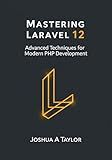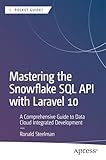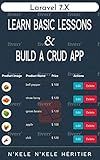Best Laravel Data Fetching Tools to Buy in December 2025

Laravel: Up & Running: A Framework for Building Modern PHP Apps



Laravel 12 for Beginners & Beyond: A Complete Guide to Building Modern PHP Web Applications with Clean Architecture, Hands-On Projects, and Best Practices



Mastering Laravel 12 : Advanced Techniques for Modern PHP Development



Architecture of complex web applications. Second Edition.: With examples in Laravel(PHP)



Mastering the Snowflake SQL API with Laravel 10: A Comprehensive Guide to Data Cloud Integrated Development (Apress Pocket Guides)



Laravel 7.X : LEARN BASIC LESSONS & BUILD A CRUD APP (PHP Framework)



The Laravel Survival Guide: Written & Updated for Laravel 5.3



Laravel Essentials: Tips & Tricks for Developers: Master Laravel with Practical Tips for Every Developer


To fetch and update data in Laravel, you can use Eloquent ORM which allows you to interact with your database tables using PHP syntax.
To fetch data, you can use methods like all() to retrieve all records from a table, find() to retrieve a single record by its primary key, or where() to query records based on certain conditions.
To update data, you can retrieve a record using find() or where() and then make changes to its attributes before calling the save() method to persist the changes to the database.
You can also use methods like update() to update multiple records at once based on certain conditions.
Overall, Laravel provides a powerful and intuitive way to fetch and update data in your application.
How to fetch data based on a specific condition in Laravel?
In Laravel, you can fetch data based on a specific condition using Eloquent, the built-in ORM (Object-Relational Mapping) provided by Laravel.
Here's an example of how you can fetch data based on a specific condition:
// Fetch all users whose status is 'active' $users = User::where('status', 'active')->get();
// Fetch a single user whose ID is equal to 1 $user = User::where('id', 1)->first();
// Fetch all users whose age is greater than 25 $users = User::where('age', '>', 25)->get();
In the above examples, User is the model class representing the users table in the database. You can replace User with the name of the model class that corresponds to your database table.
You can use various Eloquent methods such as where(), orWhere(), whereIn(), whereNotNull(), etc. to define your condition for fetching data. You can also chain multiple conditions together to fetch data based on multiple conditions.
Once you have defined your condition, you can use the get() method to fetch multiple results or the first() method to fetch the first result that matches the condition.
Remember to import your model class at the top of your controller or wherever you are writing this code:
use App\Models\User;
This is just a simple example, and there are many more advanced ways to fetch data based on specific conditions in Laravel using Eloquent. For more complex queries, you can also use query scopes, relationships, and other Eloquent features provided by Laravel.
How to optimize fetching and updating data queries in Laravel?
- Use Eager Loading: Eager loading helps to reduce the number of queries by fetching all required data in a single query. This can be achieved using the with() method in Eloquent or using the load() method on a relationship.
- Use Caching: Caching can help to reduce the number of database queries by storing the results of frequently accessed queries in memory. Laravel provides caching support through various drivers like Redis, Memcached, and file caching.
- Avoid N+1 Queries: Be careful of N+1 query issues where multiple queries are necessary to fetch related data. Use eager loading or lazy loading to fetch all required data in a single query.
- Use Database Indexing: Indexing can improve the performance of data retrieval queries by making database searches faster. Ensure that relevant columns are indexed in the database.
- Use Query Builder: Query Builder allows you to write raw SQL queries in Laravel. Use Query Builder for complex queries or queries that cannot be achieved using Eloquent.
- Limit the Number of Columns: Fetch only the necessary columns from the database instead of fetching all columns. This can reduce the amount of data transferred from the database to the application.
- Use Pagination: When fetching a large amount of data, use pagination to limit the number of records fetched in a single query. This can help improve the query performance and reduce load on the database.
- Use Queues: For tasks that involve heavy data processing or update operations, consider using queues to offload the processing from the main application thread. This can help improve application performance and responsiveness.
- Use Transactions: When updating multiple records in a single operation, wrap the update queries in a database transaction to ensure data consistency and to roll back changes if an error occurs.
- Monitor and Optimize Queries: Use tools like Laravel Debugbar or query logging to monitor the performance of data fetching and update queries. Identify slow queries and optimize them for better performance.
How to update data in Laravel using the query builder?
In Laravel, you can update data using the query builder by specifying the table you want to update, the data you want to update, and the conditions for which records to update. Here is an example of how you can update data in Laravel using the query builder:
// Update the 'users' table where the id is equal to 1 DB::table('users') ->where('id', 1) ->update(['name' => 'John Doe', 'email' => 'johndoe@example.com']);
In this example, we are updating the 'users' table where the 'id' column is equal to 1. We are updating the 'name' and 'email' columns to 'John Doe' and 'johndoe@example.com', respectively.
You can also use additional conditions to update specific records in the table. For example, you can update records where the 'status' column is equal to 'active':
// Update the 'users' table where the 'status' is equal to 'active' DB::table('users') ->where('status', 'active') ->update(['status' => 'inactive']);
In this example, we are updating the 'users' table where the 'status' column is equal to 'active'. We are updating the 'status' column to 'inactive' for these records.
You can also use the query builder to update multiple records at once by not specifying a condition. In this case, all records in the table will be updated with the specified data:
// Update all records in the 'users' table DB::table('users') ->update(['status' => 'inactive']);
In this example, we are updating all records in the 'users' table by setting the 'status' column to 'inactive' for all records.
